2 虚拟地理环境教育部重点实验室(南京师范大学), 江苏 南京 210023;
3 江苏省地理信息资源开发与利用协同创新中心, 江苏 南京 210023)
全新世,过去被认为是一个气候稳定的时期[1~2],但在20世纪70年代,Denton和Karlén[3]发现北美和欧洲的山地冰川具有同步变化的特征,从而认为全新世气候具有多变性,打破了传统上认为全新世气候具有稳定性的认识。Bond等[4]通过研究表明,北大西洋的全新世事件是独立于冰期-间冰期的气候状态而普遍存在的千年尺度气候周期,在早全新世共出现4次冰漂碎屑事件,分别发生于11.1kaB.P.、10.3kaB.P.、9.4kaB.P.和8.1kaB.P.(B.P.为相对1950A.D.)。Rasmussen等[5]通过DYE-3、GRIP和NGRIP冰芯建立了一个全新的时标,表明在早全新世的降温事件主要开始于11.5ka b2k、9.35ka b2k和8.3ka b2k(b2k为相对2000A.D.)。早全新世出现的突然降温事件不仅表现在深海沉积和极地冰芯中,在湖泊、石笋、孢粉、珊瑚、泥炭等众多记录中均有体现[6~11]。
在早全新世的降温事件研究中,“8.2ka”事件最引人注目。Alley等[12]研究表明发生在8.4~8.0kaB.P.的气候事件的振幅约为新仙女木(Younger Dryas,简称YD)事件的一半,该事件的强度、持续时间、引起的气候指标的变化都十分显著[13]。北大西洋8.2kaB.P.降温事件的影响范围远远超出了北大西洋的范围[12],来自低纬热带委内瑞拉近海Cariaco盆地的灰度值在8.2kaB.P.显著下降,指示了一个冷干事件的发生,说明此时在低纬热带也出现了显著的气候异常[14~15]。
大量的代用指标以及气候模拟表明整个北半球在8.2kaB.P.变得更冷、更干旱[16~17],在早全新世类似的事件还发生在9.2kaB.P.。但相对于“8.2ka”事件来说,“9.2ka”事件的研究较少,这些记录主要集中在中高纬度地区[18~20],少见于亚洲季风区古气候记录中。目前,对“9.2ka”事件的认识仍存在众多争议,主要表现在以下3个方面。首先是“9.2ka”事件强度的不确定性。例如,在格陵兰的GRIP、DYE-3和NGRIP 3个冰芯记录中,“8.2ka”事件的强度要大于“9.2ka”事件[21],而在亚洲夏季风地区的部分水文记录中,“9.2ka”事件强度更大[22~26]。其次是对“9.2ka”事件的持续时间的认识不一致。来自奥地利Katerloch洞的石笋显示在9.1kaB.P.左右发生了明显的气候异常,持续了70~110a[7]。Rasmussen等[5]对格陵兰冰芯中的“9.2ka”事件进行测年,确定事件持续时间在40~100a之间。挪威海的岩石地层、大化石含量、磁化率等指示在9.39kaB.P.到9.15kaB.P.出现融水峰值,持续时间长达245a[27]。第三,对“9.2ka”事件影响的认识不同。Flohr等[28]认为“9.2ka”事件并未引起大规模的区域变化。然而,Fleitmann等[20]将来自北半球10个地区的一系列高质量的古气候记录进行对比,发现在9.2kaB.P.出现了广泛而显著的气候异常,“9.2ka”事件的影响范围广大。
许多古气候记录没有足够的时间分辨率、年代学精度或灵敏度来记录短暂的(小于百年)的气候事件[29]。因定年精确和分辨率高,石笋可作为研究短尺度气候突变事件的良好材料[30~33]。阿曼Qunf洞[34]和贵州董哥洞[35]的石笋记录了全新世一系列气候事件,显示在9.2kaB.P.发生了显著的气候突变。
由于代用指标的数量有限、研究区域的范围不足,“9.2ka”事件前后亚洲夏季风的时空变化尚未清晰确立,“9.2ka”事件的持续时间、内部细节、转型特征及成因机制方面都有待进一步研究。本文选取湖北省落水洞的石笋记录,通过氧碳同位素测试和U-Th测年结果,重建了12.96~1.53kaB.P.时段亚洲夏季风演化序列,发现在9.8~9.2kaB.P.存在一个显著的弱季风事件,该事件内部存在两个次一级的振荡,整体呈“两谷夹一峰”的不对称“W”结构,该事件可能受太阳活动和北大西洋淡水注入的共同影响。
1 研究区域、材料和方法本文的石笋样品采自湖北省恩施市咸丰县落水洞(29°43′N,109°6′E) (图 1),编号为LS21。该地区年均降水量为1470mm,降水集中在4~9月,占年降水量的62 % ~88 %,属于典型的季风区。落水洞洞口海拔约975m,上覆盖板厚约30m,为含少量杂质的灰岩,由于洞内与洞外空气流通不畅,洞内相对湿度接近100 %,洞穴年均温约14℃。夏季,热带海洋的暖湿气流深入大陆腹地,给落水洞附近地区带来不少于60 %的年降雨量,而冬季,来自蒙古—西伯利亚的干冷气团南下,控制了该地区的气候变化,因此,该区域对亚洲季风的季节变化响应迅速[36]。

|
图 1 落水洞和有关洞穴的地理位置及6~9月(1990~2019年)地表风场图(1000 hPa) 图中的风矢量(黑色箭头)数据来源于NCEP/NCAR再分析数据(http://psl.noaa.gov/cgi-bin/data/getpage.pl);红色五角星表示落水洞位置,黑色圆点表示文中涉及的其他洞穴的位置 Fig. 1 The locations of Luoshui Cave and other caves and surface wind field(1000 hPa)from June to September during 1990~2019. Wind vectors(black arrows)are based on the NCEP/NCAR reanalysis datasets. The locations of Luoshui Cave(red star)and other caves (black circles)mentioned in the article are shown in the map |
石笋LS21呈圆柱状,生长轴长550mm,直径约为40~50mm(图 2)。沿生长轴切开并抛光,由于石笋顶端质地较脆,切割时顶端破碎,无法拼接完整,石笋部分生长层段有溶孔,表明石笋生长速率较快[37],石笋LS21抛光面上存在多处岩性和颜色变化。在抛光面上用直径为0.9mm的牙钻钻取碳酸钙粉末,共获得23个铀系年代样品,采用多接收器电感耦合等离子体质谱仪(MC-ICP-MS)对U/Th数据进行分析,在南京师范大学地理科学学院同位素实验室完成测试,实验方法参照Shao等[38],年龄分析误差为±2σ。用直径为0.5mm的钻头沿石笋生长轴每隔0.5mm取一个样,共获得1099个同位素样品,分析工作在南京师范大学地理科学学院完成,将样品放置在与Finnigan MAT-253质谱仪相连的碳酸盐自动进样装置(Kiel Carbonate Device)中进行测试,结果采用VPDB(Vienna Pee Dee Belemnite)标准,分析误差小于0.05 ‰。
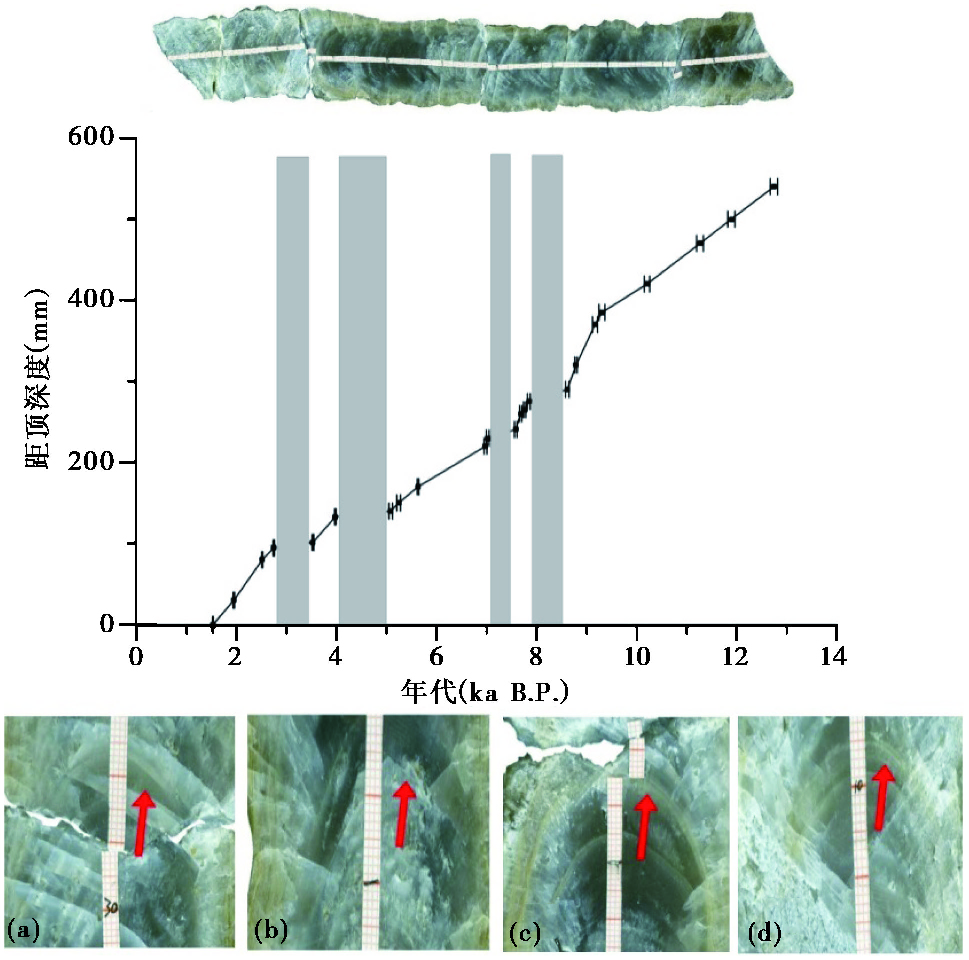
|
图 2 落水洞LS21年龄模式和石笋样品图 黑色误差棒表示石笋230Th年龄及误差(±2σ),灰色条带指示沉积间断,(a)~ (d)分别为LS21不同深度图,红色箭头指示可能发生沉积间断处 Fig. 2 Age model and stalagmite sample LS21 from Luoshui Cave. Black error bars indicate 230Th ages and dating errors(±2σ). The gray bars indicate hiatus. Different depths are denoted from (a) to (d), and the red arrows indicate where hiatus may occur |
本文在表 1中给出了石笋LS21的23个铀系测年结果,测年误差相对较小,LS21的年龄最大误差为±73a,最小误差为±9a。样品的238 U含量相对较高(0.5×10-6~1.0×10-6),而232 Th含量相对较低(0.1×10-9~3.2×10-9),由U衰变的230Th越多,则表示U-Th定年精度越高,高238 U含量和高230Th/232 Th比值为该石笋样品获得高精度的年代数据提供了基础。通过对实测年龄点线性内插建立了12.96~1.53kaB.P.的亚洲夏季风演化时间序列(图 2)。
| 表 1 LS21石笋MC-ICP-MS铀系测年结果* Table 1 MC-ICP-MS U-series dating results for stalagmite LS21 |
根据石笋的测年结果(表 1)、岩性变化(图 2)和沉积速率变化,推断LS21石笋可能存在4处沉积间断。LS21石笋在290~275mm(图 2a)(8.62~7.84kaB.P.)和240.5~230.0mm(图 2b)(7.58~7.02kaB.P.)两个区间沉积速率的变化幅度都较小,平均沉积速率为0.019mm/a,石笋在距顶277mm处有黄色的沉积条带,在距顶240.5~230.0mm之间虽未出现暗色沉积条带,但石笋岩相发生了明显变化,由上部的暗黑色半透明状转变为乳白色不透明状,可能存在沉积间断。LS21石笋在140~133mm(图 2c)(5.08~3.98kaB.P.)和101.5~94.5mm(图 2d)(3.53~2.75kaB.P.)两处的沉积速率都很小,分别为0.006mm/a和0.009mm/a,石笋在距顶135mm处生长轴中心发生了偏移,且存在较明显的黄色沉积条带,而在距顶100mm处也存在黄色条带状沉积,但不是很明显,主要通过较低的沉积速率和测年结果来判定。洞穴石笋出现沉积间断是普遍存在的地质现象,影响因素多样,发生长期的沉积间断可能是由于气候-环境冷暖旋回性变化发生间歇性停滴[39]。该石笋4处沉积间断皆发生在全新世冷时期,如“4.2ka”事件和“8.2ka”事件[40],四处沉积间断的持续时间较短,不可能是岩溶系统变化的原因,而是洞穴系统外部环境变化。外部因素有两种:1)降水减少或无,导致无滴水供应石笋生长;2)有滴水供应,但饱和度不够,说明土壤生态条件变化,特别是CO2浓度显著降低。
2.2 氧碳同位素序列对于氧同位素δ 18O的解释开始于20世纪70年代[41],Wang等[42]对南京葫芦洞的研究表明夏/冬季降水比率可以作为解释δ 18O变化较大的原因,研究中进一步解释氧同位素的指代意义,认为石笋δ 18O的变化与夏季风强弱有关[43~44]。此后越来越多的研究表明我国季风区石笋δ 18O记录主要反映的是亚洲季风强度的变化,当石笋δ 18O值偏正,反映季风强度减弱,反之则表明季风强度增加[45]。如程海等[46]对葫芦洞和董哥洞进行研究,表明中国南方石笋氧同位素在冰期/间冰期或冰段/间冰段的尺度上与亚洲夏季风的强度呈反相关。综合上述研究成果,本文认为LS21的石笋δ 18O指代的气候意义是亚洲夏季风强度的变化。
图 3为石笋LS21的氧碳同位素序列,平均分辨率约为11a,其中δ 18O在-9.4 ‰ ~-6.7 ‰之间波动,平均值为-8.4 ‰。LS21的δ 18O值在YD阶段呈现偏正趋势,直到δ 18O达到最大值-9.4 ‰,之后逐渐变小,YD的振幅达到1.7 ‰。由于不同洞穴YD事件的石笋δ 18O值存在0.7 ‰的差异[47],且该石笋可能未包含YD事件的全部过程,因此导致YD事件的振幅较小;此后δ 18O值逐渐偏负,直到在9~8kaB.P.之间达到最小值,表明此时亚洲季风逐渐增加;在8kaB.P.到5kaB.P.期间,δ 18O均值稳定在-8.9 ‰左右,振幅在1 ‰以内,由于此时正值全新世大暖期[48~49],气候较稳定,亚洲季风整体较强;在5.0kaB.P.到1.5kaB.P.,随着太阳辐射量的减少,δ 18O的值逐渐偏正,指示此时亚洲季风逐渐减弱。

|
图 3 LS21的氧碳同位素序列 灰色条带指示沉积间断,误差棒表示2σ年龄误差 Fig. 3 Oxygen and carbon isotope sequence from sample LS21. The gray bars indicate hiatus and the error bars show the 2σ age errors |
LS21碳同位素的值在-7.6 ‰ ~-2.2 ‰范围内波动,波动幅度较大。虽然石笋δ 13C具有敏感地反映气候变化的潜力,但是由于影响因素的复杂性,导致对碳同位素的分析还存在较大困难[50~53],因此本文不对δ 13C进行详细分析。
根据Hendy检验准则[41],对LS21分别选取5个不同生长层,每层沿生长轴向一侧以3mm间距分别取5个样品进行同位素测试,结果显示各层δ 18O值的变化范围在0.2 ‰之内,说明在每一层的δ 18O基本一致(图 4a),并且显示在单个生长层内δ 18O和δ 13C之间没有明显的正相关关系(图 4b)。上述检验结果表明,LS21石笋很可能达到了同位素分馏平衡,可进行古气候重建。
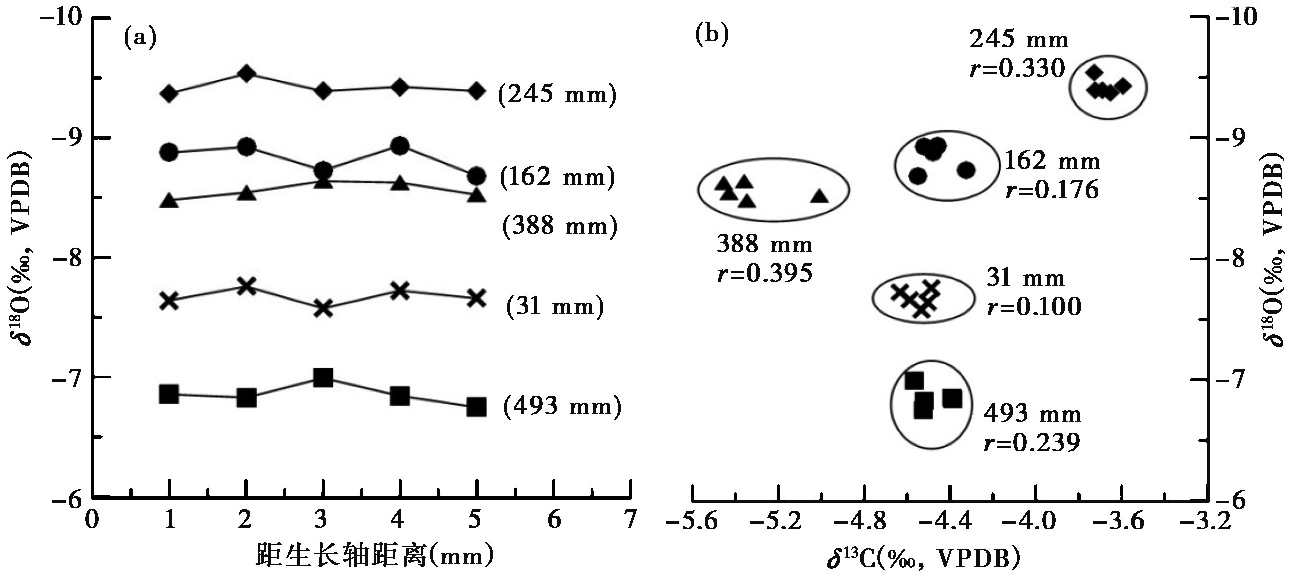
|
图 4 落水洞LS21的Hendy检验结果 (a)距石笋顶部不同深度各层位的δ 18O值;(b)同一生长层δ 18O和δ 13C的关系 Fig. 4 Results of "Hendy test" for the sample LS21 from Luoshui Cave. (a)The δ 18O variance within growth layers varies at different depths from the top; (b)Plots of δ 18O versus δ 13C for subsamples from the same layer |
然而,也有研究指出Hendy检验准则的局限性,提出“重复性”检验是证明同位素达到平衡分馏的可靠标准[54]。但目前落水洞跨越全新世范围的数据尚未发表,因此采用亚洲季风区的石笋进行重复性检验。落水洞记录(图 5a)与湖北和尚洞(图 5b)[55]、贵州董哥洞(图 5c)[35]、阿曼Qunf洞(图 5d)[34]在千年尺度事件上基本上具有重现性,在轨道尺度上与65°N夏季太阳辐射曲线(图 5e)[56]变化趋势一致,证实了LS21 δ 18O记录的可靠性。

|
图 5
亚洲季风区石笋记录
(a)湖北落水洞LS21(29°43′N,109°06′E);(b)湖北和尚洞HS-4(30°27′N,110°25′E) [55];(c)贵州董哥洞D4(25°17′N,108°05′E) [35];(d)阿曼Qunf洞Q5(17°10′N,54°18′E) [34];(e)65°N夏季太阳辐射[56] 灰色条带分别对应“9.2ka”、“8.2ka”、“4.2ka”和“2.8ka”事件 Fig. 5 The stalagmite records in Asian monsoon area. (a)LS21 from Luoshui Cave in Hubei(29°43′N, 109°06′E); (b)HS-4 from Heshang Cave in Hubei(30°27′N, 110°25′E) [55]; (c)D4 from Dongge Cave in Guizhou(25°17′N, 108°05′E) [35]; (d)Q5 from Qunf Cave in Oman(17°10′N, 54°18′E) [34]; (e)The Northern Hemisphere 65°N summer insolation[56]. The gray bars indicate 9.2ka, 8.2ka, 4.2ka and 2.8ka events, respectively |
本文研究的落水洞位于东亚季风区,石笋δ 18O记录在9.8~9.2kaB.P.之间显著偏正(图 5a和图 6f),表明东亚夏季风强度突然减弱。受控于东亚夏季风的和尚洞(图 5b),其石笋δ 18O在9.2kaB.P.左右出现显著偏正趋势[55]。此外,东亚季风区的其他水文记录中同样显示出东亚夏季风在9.2kaB.P.左右减弱[25, 35]。大九湖盆地泥炭Rb/Sr主要代表了化学风化作用的强度[57],如图 6a所示,Rb/Sr在9.4kaB.P.大幅增加,表明该区经历了一次显著的气候变冷,可能源于东亚夏季风强度的突然减弱[57]。Jia等[25]认为Δδ 13C31-29能反映湖光岩玛珥湖地区夏季风强度的变化,当Δδ 13C31-29偏负,表明东亚夏季风增强,Δδ 13C31-29在9.5kaB.P.左右偏正(图 6b),说明东亚夏季风明显减弱。
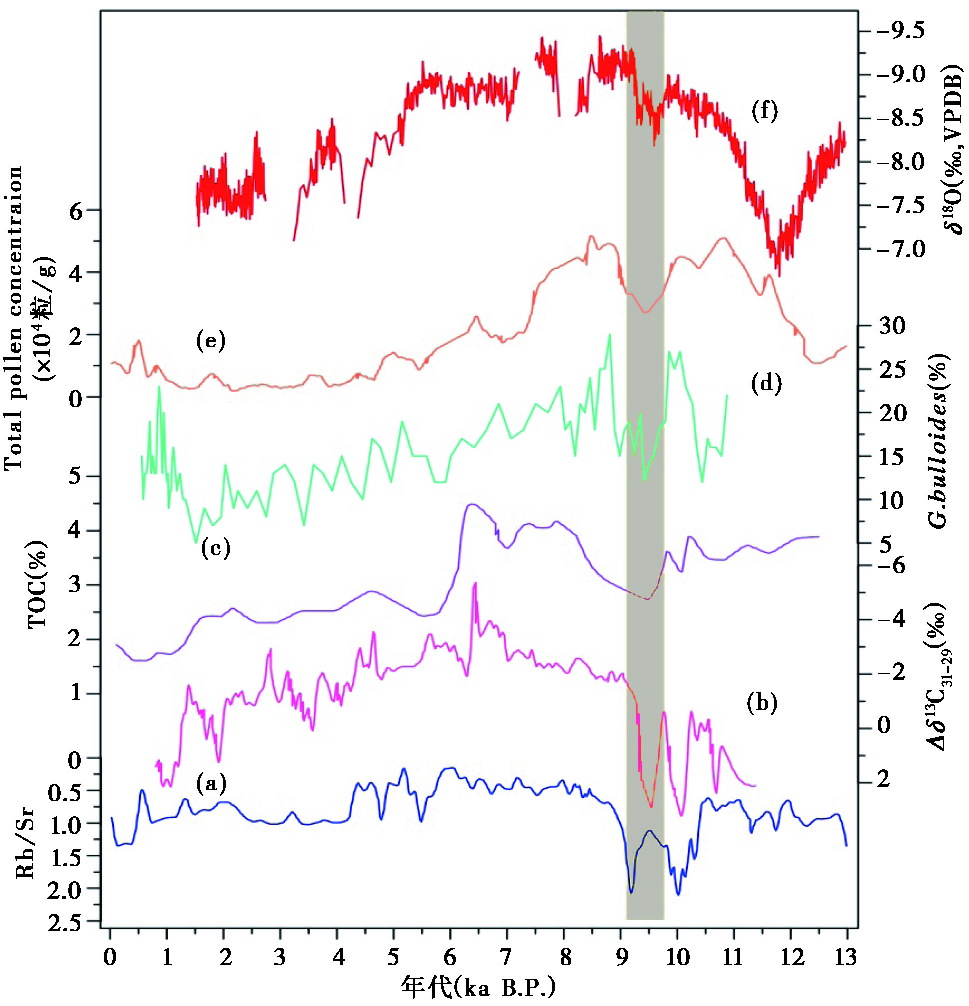
|
图 6
“9.2 ka”事件的亚洲夏季风区的水文气候记录
(a)大九湖泥炭Rb/Sr[57];(b)湖光岩玛珥湖Δδ13C31-29记录[25];(c)洱海TOC含量记录的5点平滑曲线记录[58];(d)阿拉伯海的钻孔ODP723A的G.bulloides记录[22];(e)青海湖总花粉浓度记录[59];(f)落水洞δ 18O记录 灰色条带表示9.2kaB.P.左右亚洲夏季风突然减弱 Fig. 6 Hydrological climate records of the 9.2ka event in the Asian summer monsoon region. (a)Rb/Sr ratio of the Dajiuhu peat[57]; (b)Δδ13C31-29 of the Huguangyan Maar Lake[25]; (c)The 5-point running average curve of the TOC in Erhai Lake[58]; (d)G.bulloides percentage in Hole ODP723A from the Arabian Sea[22]; (e)The total pollen concentration in Qinghai Lake[59]; (f)The δ 18O record from Luoshui Cave. The gray bar indicates abrupt decrease of the Asian summer monsoon at around 9.2kaB.P. |
南亚季风区全新世高分辨率记录也显示南亚夏季风在9.2kaB.P.左右突然减弱。贵州董哥洞D4(图 5c)和阿曼Qunf洞Q5(图 5d)石笋记录了9.2kaB.P.的δ 18O大幅偏正[34~35]。洱海(25°25′~26°10′N,99°32′~100°27′E)的总有机碳(Total Organic Carbon,简称TOC)含量在9.5kaB.P.突然下降,表明此时的南亚季风强度大幅度减弱,湖泊生产力下降[58](图 6c)。Gupta等[22]分析了阿拉伯海钻孔ODP723A(18°03.079′N,57°36.561′E)的G.bulloides记录在9.5~9.0kaB.P.大幅下降,说明此时南亚夏季风明显减弱(图 6d)。位于东南季风、西南季风和西风急流交汇地带的青海湖地区(36°15′~38°20′N,97°50′~101°20′E)对气候响应十分敏感,该区花粉浓度(图 6e)和有机C、N含量在9.8~9.1kaB.P.减小,说明此时出现喜冷干的植被,9.4kaB.P.花粉浓度降至最低,说明此时亚洲夏季风明显减弱[59]。
综上所述,在受亚洲季风控制的地区,包括东亚季风区和南亚季风区,在9.2kaB.P.左右均出现夏季风显著减弱的现象。
3.2 “9.2ka”事件的起止时间和转型特征“RAMPFIT”法在古气候重建和事件转型时间确定方面得到了广泛应用[60~61],它使用Weighted LS(加权最小二乘法)将“斜坡”(ramp)拟合到测量数据,目的是测量时间序列平均值的转变,从而获取事件开始发生转变的时间和转型前后的平均水平[62]。即如果两种不同气候态之间的转换是线性过程,就可以利用“RAMPFIT”方法确定突变事件的起止时间。如Fleitmann等[34]运用该方法将阿曼Qunf洞与GRIP的δ 18O记录进行对比,得出季风降水的突然增加与北大西洋地区气温的升高是同步变化的结论。Röthlisberger等[63]利用该方法对南极冰芯EPICA Dome C的不同代用指标进行分析,得出9个冰期终止期的起止时间以及变化过程,姜修洋等[64]用其证明了全新世适宜期结束时间在亚洲季风区具有显著差异。
在“9.2ka”事件内部,落水洞石笋LS21δ 18O的值在9808aB.P.开始缓慢增加,直到9589aB.P.,δ 18O的值到达最大值-8.173 ‰,在9306aB.P.处,δ 18O的值开始迅速偏负,直到9228aB.P.达到最小值-9.265 ‰,标志着“9.2ka”事件结束(表 2)。在事件内部,存在次一级的振荡,总体偏负,曲线总体特征表现为“两峰夹一谷”的特征,类似于“W”型结构。由于事件在开始时缺乏年代控制(图 7),所以事件开始持续的时间存在不确定性,但是在事件结束时,有两个年龄点控制,事件结束的时间基本准确,整个事件的振荡幅度达1.1 ‰。“9.2ka”事件从开始发生转型到完全结束共历时580a,其中,季风开始减弱直到δ 18O达到最小值持续了约219a,约占整个事件历时的38 %,亚洲夏季风在事件开始时缓慢减弱,但在结束时期,却呈现迅速变化的特征,持续时间仅有78a。这一“开始缓慢减弱,结束迅速增强”的转型模式在全新世其他的亚洲季风减弱事件中均有体现[65](表 3)。580a的历时不同于过去对于“9.2ka”事件的认识,Boch等[7]研究表明“9.2ka”事件的持续时间为70~110a,但本文的“9.2ka”事件持续时间较长,甚至接近YD事件的开始转型的持续时间[41, 47],这可能是因为“9.2ka”事件在不同纬度的持续时间不同,在格陵兰冰芯中,δ 18O值从9.3kaB.P.开始减弱,持续时间在40~100a之间[5],而在低纬阿拉伯海的钻孔ODP723A中,G.bulloides的百分比含量在9.5~9.0kaB.P.明显减少[22],还可能与落水洞敏感的岩溶系统有关。
| 表 2 “RAMPFIT”法分析结果* Table 2 The results of "RAMPFIT" analysis |
| 表 3 全新世亚洲弱季风事件的初始转型持续时间和内部结构[65] Table 3 Initial transitional duration and internal structure of Asian weak monsoon event in the Holocene |
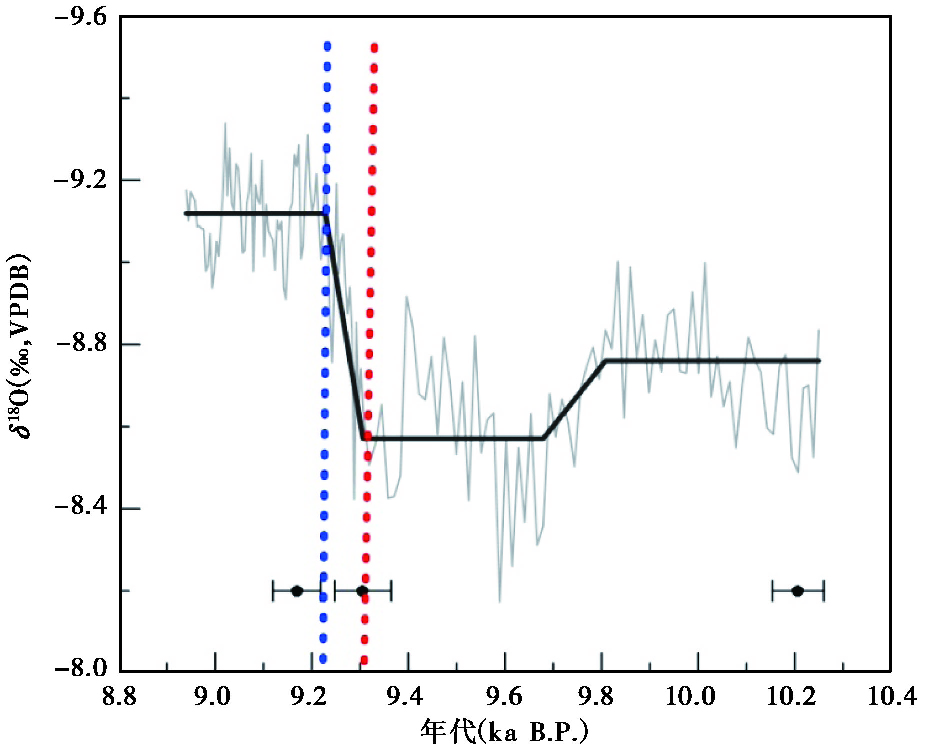
|
图 7 落水洞石笋LS21记录的“9.2ka”事件转型模型 黑色实线表示的是“RAMPFIT”方法的分析结果,其中的垂直点虚线表示的是“9.2ka”事件结束时发生转换的开始和结束时间 Fig. 7 The transitional pattern of the 9.2ka event recorded by Sample LS21 from Luoshui Cave. The solid black line indicates the analysis result of the RAMPFIT, in which the vertical dotted lines indicate the start and end times of the transition at the end of the 9.2ka event |
为进一步探究全新世的弱季风事件的转型特征和内部结构,本文选取了亚洲季风区不同时期的弱季风事件进行研究[66~68](图 8),大部分事件的内部都存在次一级的气候振荡,这与落水洞的“9.2ka”事件基本一致,但其中“2.8ka”事件[66](图 8a)与“4.2ka”事件[67](图 8b)呈现的是“三谷夹两峰”的结构,这可能是由于早全新世与中晚全新世的气候边界条件和驱动机制不同导致的。早全新世期间,北半球夏季太阳辐射增强,大陆冰盖迅速消融[69],淡水注入北大西洋引起温盐环流减弱,导致全球气候发生变化,“8.2ka”事件的产生通常认为是由冰盖崩塌导致的[12,70]。中晚全新世期间太阳辐射逐渐减弱,冰盖几乎全部融化[71],海平面升高,从而引起气候系统内部振荡,导致弱季风事件发生。除“4.2ka”事件外(图 8b),其余弱季风事件皆是开始时季风缓慢减弱,结束时迅速增强(图 8a、8c和8d),但不同洞穴的“4.2ka”事件记录也存在一定差异,如印度东北的Mawmluh洞的弱季风开始持续时间占整个事件历时的68 %,而董哥洞仅占14 % [65](表 3),这可能是由不同洞穴的环境噪音造成的。
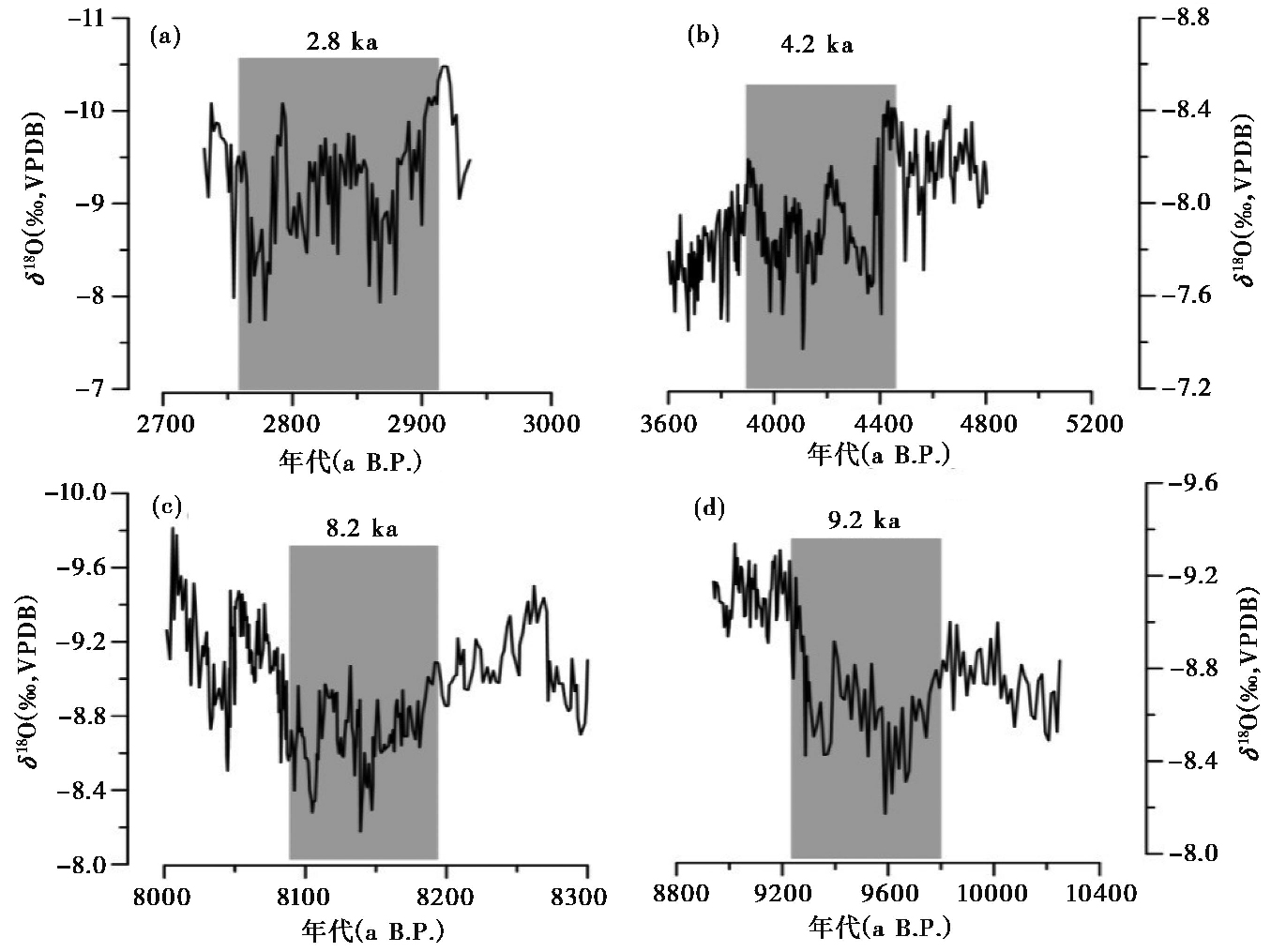
|
图 8
亚洲季风区全新世不同弱季风事件记录对比
(a)永兴洞δ 18O记录(31°35′N,111°14′E) [66];(b)董哥洞δ 18O记录(25°17′N,108°05′E)[67];(c)青天洞δ 18O记录(31°20′N,110°22′E) [68];(d)落水洞δ 18O记录(29°43′N,109°06′E) 灰色条带分别表示不同的气候突变事件 Fig. 8 Comparison of records of different weak monsoon events in the Asian monsoon during the Holocene. (a)The record of δ 18O in Yongxing Cave(31°35′N, 111°14′E) [66]; (b)The record of δ 18O in Dongge Cave(25°17′N, 108°05′E)[67]; (c)The record of δ 18O in Qingtian Cave(31°20′N, 110°22′E)[68]; (d)The record of δ 18O in Luoshui Cave(29°43′N, 109°06′E). The gray bars shows different abrupt climate events as well as the 2.8ka event |
“9.2ka”事件广泛存在于北半球中高纬的地质记录中,如NGRIP、GRIP和DYE-3等格陵兰冰芯[21, 72]都反映出在9.2kaB.P.时δ 18O出现明显偏正的趋势,虽然偏正趋势小于“8.2ka”事件,但是同样指示了气候变冷的事实[5](图 9a)。阿拉斯加亚北极Arolik湖的生物硅记录[73]也显示出9.17kaB.P.出现了明显的气候异常,气候变得冷湿(图 9b)。在欧洲中部,来自Ammersee湖的介形虫δ 18O序列也显示在9.18kaB.P.发生了一次明显的冷事件[74](图 9c)。北大西洋的岩芯MC52-VM29-191在9.5kaB.P.染色赤铁矿颗粒比例增加,指示季风强度明显减弱[75](图 9d)。
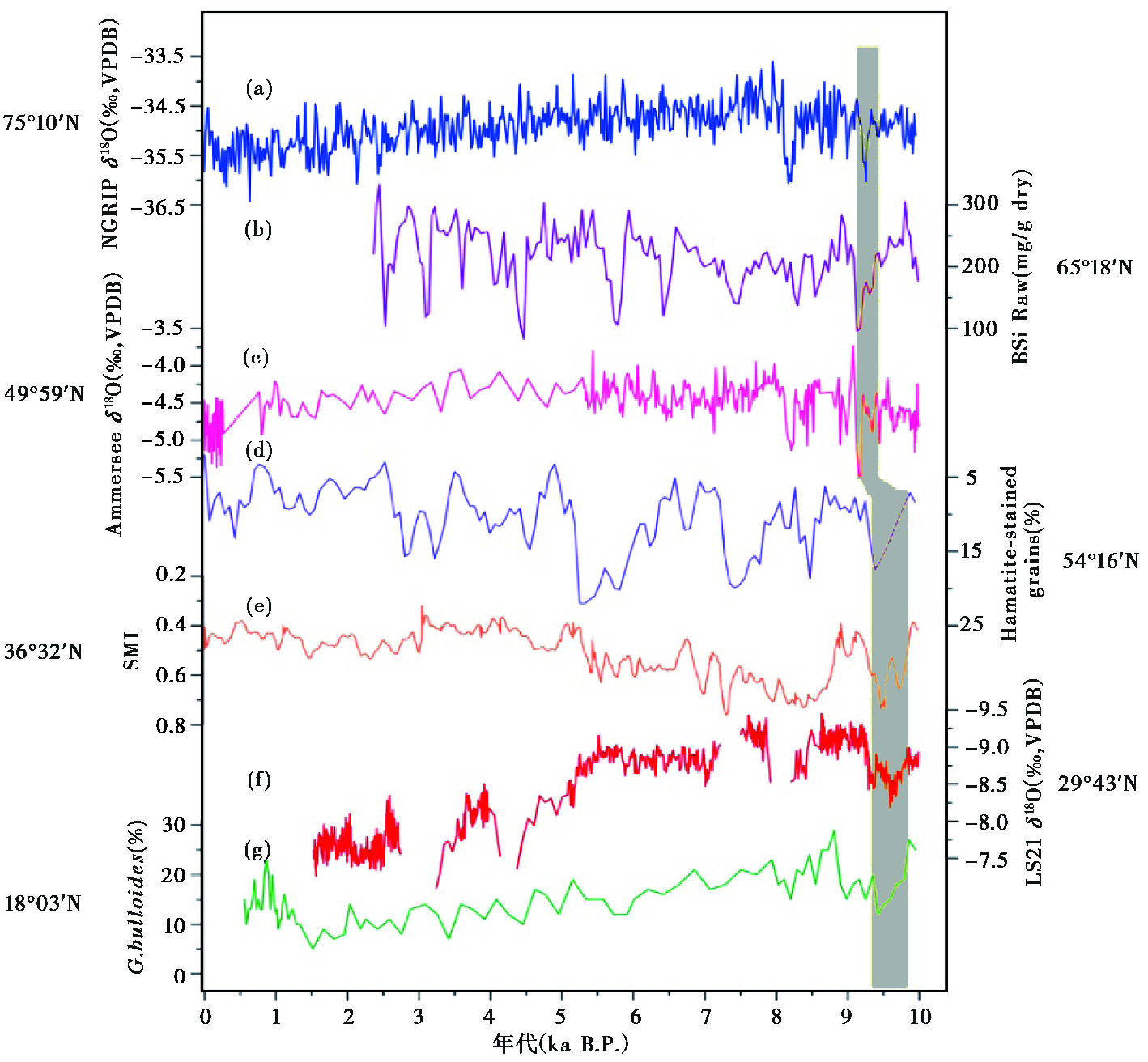
|
图 9
不同纬度的“9.2ka”事件记录
(a)格陵兰冰芯NGRIP记录[5];(b)阿拉斯加亚北极Arolik湖的生物硅记录[73];(c)Ammersee湖的介形虫δ 18O记录[74];(d)北大西洋MC52-VM29-191染色赤铁矿颗粒含量[75];(e)青海湖东亚夏季风指数(SMI)[24];(f)LS21石笋δ 18O记录;(g)阿拉伯海的钻孔ODP723A的G.bulloides记录[22] 灰色条带表示“9.2ka”事件 Fig. 9 9.2 ka event records at different latitudes. (a)Record from the North GRIP cores in Greenland[5]; (b)BSi from Arolik lake record in the Alaskan Subarctic[73]; (c)Ostracod δ 18O record from Lake Ammersee[74]; (d)Haematite percentage in core MC52-VM29-191 from the North Atlantic[75]; (e)Lake Qinghai Asian summer monsoon index[24]; (f)Speleothem δ 18O record from LS21; (g)G.bulloides percentage in Hole ODP723A from the Arabian Sea[22]. The gray bar indicates 9.2ka event |
9.2kaB.P.的亚洲季风减弱对应于北大西洋冰漂碎屑记录中的第6个峰值[4],说明北大西洋淡水注入可能是“9.2ka”事件的驱动机制。北大西洋地区淡水大量注入一度成为解释全新世百年-千年尺度快速气候事件发生的重要机制[76~77]。研究表明北大西洋的淡水注入可能会导致亚洲夏季风的减弱,Lu和Dong[78]模拟结果表明淡水注入对亚洲夏季风有明显的抑制作用。有研究表明这种较小的千年尺度振荡事件是北半球冰盖消融引起的,在淡水注入北大西洋后通过大气遥相关导致亚洲季风减弱[79]。通过模型模拟发现北大西洋淡水注入会导致温盐环流大幅减弱,从而导致大西洋和太平洋上的热带辐合带(Intertropical Convergence Zone,简称ITCZ)南移,并通过海气相互作用削弱印度和亚洲夏季风[80]。
北大西洋淡水注入不仅能影响北大西洋沿岸气候,还能使太平洋和印度洋的季风减弱,这很可能是“9.2ka”事件发生的驱动机制。北高纬地区的研究发现,“9.2ka”事件的淡水注入规模要比“8.2ka”事件小得多[20],从NGRIP冰芯的δ 18O记录[5]可以看出(图 9a),“9.2ka”事件的振幅要小于“8.2ka”事件,但在部分亚洲季风区古水文记录中[22, 24],“9.2ka”事件的变化幅度却要大于“8.2ka”事件(图 9e和9g),本文记录由于在8.2kaB.P.处出现沉积间断(图 9f),无法比较两者大小,但“9.2ka”事件记录的持续时间与一些亚洲季风区古水文记录基本一致,这表明“9.2ka”事件可能不仅受到北大西洋淡水注入的影响,还可能受到另一因素的影响,即太阳活动的影响。
太阳活动通常用于解释气候记录中观察到的百年或更短尺度变化的机制,太阳活动变化的一个常用代用指标是14 C,它的产生与地球经历的磁屏蔽程度有关[35]。将董哥洞的δ 18O进行光谱分析可以看出δ 18O中存在208a和86a两个周期,这与Δ14 C中两个太阳周期相似,表明亚洲季风强度随着太阳活动变化而变化,与中国大部分地区对太阳活动的响应相似[35],阿曼南部的Q5记录进行调谐后与去趋势后的Δ 14 C有很强的相似性,证实了太阳活动和季风密切的相关性[34]。
为了进一步研究“9.2ka”事件的驱动机制,本文对10.7~8.7kaB.P.时段的LS21石笋使用Redfit软件进行功率谱分析,显示通过95 %置信度的周期有76a和29a(图 10)。Wang等[67]将董哥洞石笋DA的δ 18O序列与树轮Δ 14 C进行交叉谱分析,得出共同周期成分有89a、57a、54a、46a和29a。说明太阳活动能够影响季风的变化,但在进入地球内部系统后,需要通过放大机制将其能量传输到两极地区,因此温盐环流就成为了一条重要的机制,借助温盐环流将能量输往两极地区,在9.2kaB.P.左右,太阳活动减弱,而此时又存在淡水注入事件,导致温盐环流减弱,使得赤道辐合带南移,促使亚洲夏季风减弱。
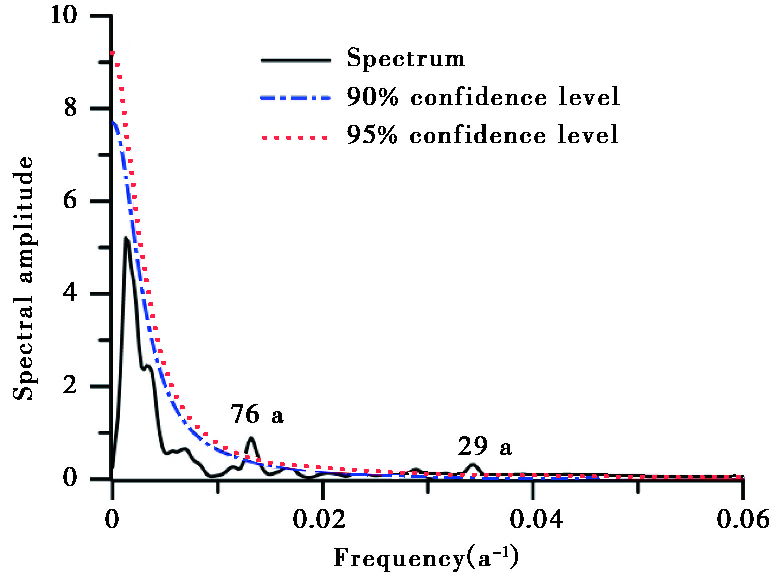
|
图 10 LS21石笋δ 18O记录的功率谱分析结果 Fig. 10 Spectral analysis results for LS21δ 18O record |
(1) LS21的石笋δ 18O指示的是亚洲夏季风强度的变化,通过对比亚洲夏季风区的水文气候记录可知,在受亚洲季风控制的地区,包括东亚季风区和南亚季风区,在9.2kaB.P.左右均出现夏季风显著减弱的现象。
(2) 通过氧碳同位素测试,获取高分辨率的湖北落水洞石笋记录,显示在9.2kaB.P.出现了一次弱季风事件,“RAMPFIT”法显示,该事件的持续时间为9.8~9.2kaB.P.,整个事件持续时间超过500a,可能是因为“9.2ka”事件在不同纬度表现不同,同时还与落水洞敏感的岩溶系统有关。将“9.2ka”事件与全新世不同冷事件对比,发现“9.2ka”事件内部,存在两个次一级的振荡,曲线总体特征表现为“两峰夹一谷”的特征,类似于“W”型结构。这与“2.8ka”事件和“4.2ka”事件的“三峰夹两谷”的结构不同,这可能是由于早全新世与中晚全新世的气候边界条件和驱动机制不同导致的。同时还发现,“9.2ka”事件在开始时表现出缓慢减弱(219a)、结束时迅速增强(78a)的特征,这与大部分全新世弱季风事件的变化特征是一致的。
(3)“9.2ka”事件驱动机制的研究是通过将石笋LS21δ 18O进行功率谱分析进行的,发现周期76a和29a,与太阳活动的周期相似,且该事件的内部结构与低纬的气候水文记录更相似,说明太阳活动可能是引发该事件发生的主要机制,而北大西洋的淡水注入是一部分影响因素,太阳活动减弱,加上北大西洋淡水注入导致温盐环流减弱,使得ITCZ南移,促使亚洲夏季风减弱。
致谢: 感谢审稿专家和编辑部杨美芳老师宝贵的修改意见,在此一并感谢!
| [1] |
Dansgaard W, Johnsen S J, Clausen H B, et al. Evidence for general instability of past climate from a 250-kyr ice-core record[J]. Nature, 1993, 364(6434): 218-220. DOI:10.1038/364218a0 |
| [2] |
Grootes P M, Stuiver M, White J W C, et al. Comparison of oxygen isotope records from the GISP2 and GRIP Greenland ice cores[J]. Nature, 1993, 366(6455): 552-554. DOI:10.1038/366552a0 |
| [3] |
Denton G H, Karlén W. Holocene climatic variations:Their pattern and possible cause[J]. Quaternary Research, 1973, 3(2): 155-205. DOI:10.1016/0033-5894(73)90040-9 |
| [4] |
Bond G, Showers W, Cheseby M, et al. A pervasive millennial-scale cycle in North Atlantic Holocene and glacial climates[J]. Science, 1997, 278(5341): 1257-1266. DOI:10.1126/science.278.5341.1257 |
| [5] |
Rasmussen S O, Vinther B M, Clausen H B, et al. Early Holocene climate oscillations recorded in three Greenland ice cores[J]. Quaternary Science Reviews, 2007, 26(15-16): 1907-1914. DOI:10.1016/j.quascirev.2007.06.015 |
| [6] |
Hou Juzhi, Huang Yongsong, Shuman B N, et al. Abrupt cooling repeatedly punctuated Early-Holocene climate in eastern North America[J]. The Holocene, 2012, 22(5): 525-529. DOI:10.1177/0959683611427329 |
| [7] |
Boch R, Spötl C, Kramers J. High-resolution isotope records of Early Holocene rapid climate change from two coeval stalagmites of Katerloch Cave, Austria[J]. Quaternary Science Reviews, 2009, 28(23-24): 2527-2538. DOI:10.1016/j.quascirev.2009.05.015 |
| [8] |
Lézine A M, Tiercelin J J, Robert C, et al. Centennial to millennial-scale variability of the Indian monsoon during the Early Holocene from a sediment, pollen and isotope record from the desert of Yemen[J]. Palaeogeography, Palaeoclimatology, Palaeoecology, 2007, 243(3-4): 235-249. DOI:10.1016/j.palaeo.2006.05.019 |
| [9] |
Beck J W, Récy J, Taylor F, et al. Abrupt changes in Early Holocene tropical sea surface temperature derived from coral records[J]. Nature, 1997, 385(6618): 705-707. DOI:10.1038/385705a0 |
| [10] |
谢哲宇, 裘冰倩, 肖河, 等. 东北哈尼泥炭14 ka B.P.以来大气汞沉降历史记录[J]. 第四纪研究, 2019, 39(6): 1333-1345. Xie Zheyu, Qiu Bingqian, Xiao He, et al. Study on the atmospheric mercury deposition data that retrieved from Hani peat in Northeast China since 14 ka B.P.[J]. Quaternary Sciences, 2019, 39(6): 1333-1345. |
| [11] |
杨东, 罗超, 彭子成, 等. 新疆罗布泊地区32.0~9.1 ka B.P.期间的孢粉记录及其古气候古环境演化[J]. 第四纪研究, 2009, 29(4): 755-766. Yang Dong, Luo Chao, Peng Zicheng, et al. A pollen record and the paleoclimatic and environmental evolution in Lop-Nur, Xinjiang in 32.0~9.1 ka B.P.[J]. Quaternary Sciences, 2009, 29(4): 755-766. DOI:10.3969/j.issn.1001-7410.2009.04.11 |
| [12] |
Alley R B, Mayewski P A, Sowers T, et al. Holocene climatic instability:A prominent, widespread event 8200 yr ago[J]. Geology, 1997, 25(6): 483-486. DOI:10.1130/0091-7613(1997)025<0483:HCIAPW>2.3.CO;2 |
| [13] |
Cheng H, Fleitmann D, Edwards R L, et al. Timing and structure of the 8.2 kyr B.P. event inferred from δ18O record of stalagmites from China, Oman, and Brazil[J]. Geology, 2009, 37(11): 1007-1010. DOI:10.1130/G30126A.1 |
| [14] |
Hughen K A, Overpeck J T, Peterson L C, et al. Rapid climate changes in the tropical Atlantic region during the last deglaciation[J]. Nature, 1996, 380(6569): 51-54. DOI:10.1038/380051a0 |
| [15] |
Hughen K A, Overpeck J T, Lehman S J, et al. A new 14C calibration data set for the Last Deglaciation based on marine varves[J]. Radiocarbon, 1998, 40(1): 483-494. |
| [16] |
Alley R B, Ágústsdóttir A M. The 8 k event:Cause and consequences of a major Holocene abrupt climate change[J]. Quaternary Science Reviews, 2005, 24(10-11): 1123-1149. DOI:10.1016/j.quascirev.2004.12.004 |
| [17] |
何鹏, 刘健, 刘斌, 等. 全新世两次典型突变事件下北半球季风降水的变化对比[J]. 第四纪研究, 2019, 39(6): 1372-1883. He Peng, Liu Jian, Liu Bin, et al. Comparison of changes of Northern Hemisphere monsoon precipitation between two typical abrupt climate events in Holocene[J]. Quaternary Sciences, 2019, 39(6): 1372-1883. |
| [18] |
Dean J R. Stable Isotope Analysis and U-Th Dating of Late Glacial and Holocene Lacustrine Sediments from Central Turkey[D]. Nottingham: The PhD Thesis of University of Nottingham, 2014: 141-142.
|
| [19] |
Marino G, Rohling E J, Sangiorgi F, et al. Early and Middle Holocene in the Aegean Sea:Interplay between high and low latitude climate variability[J]. Quaternary Science Reviews, 2009, 28(27-28): 3246-3262. DOI:10.1016/j.quascirev.2009.08.011 |
| [20] |
Fleitmann D, Mudelsee M, Burns S J, et al. Evidence for a widespread climatic anomaly at around 9.2 ka before present[J]. Paleoceanography, 2008, 23(1): 1-6. |
| [21] |
Vinther B M, Clausen H B, Johnsen S J, et al. A synchronized dating of three Greenland ice cores throughout the Holocene[J]. Journal of Geophysical Research:Atmospheres, 2006, 111: D1102. DOI:10.1029/2005JD006921 |
| [22] |
Gupta A K, Anderson D M, Overpeck J T. Abrupt changes in the Asian southwest monsoon during the Holocene and their links to the North Atlantic Ocean[J]. Nature, 2003, 421(6921): 354-357. DOI:10.1038/nature01340 |
| [23] |
Gupta A K, Das M, Anderson D M. Solar influence on the Indian summer monsoon during the Holocene[J]. Geophysical Research Letters, 2005, 32: L17703. DOI:10.1029/2005GL022685 |
| [24] |
An Z, Colman S M, Zhou W, et al. Interplay between the Westerlies and Asian monsoon recorded in Lake Qinghai sediments since 32 ka[J]. Scientific Reports, 2012, 2(8): 619. |
| [25] |
Jia G, Bai Y, Yang X, et al. Biogeochemical evidence of Holocene East Asian summer and winter monsoon variability from a tropical maar lake in Southern China[J]. Quaternary Science Reviews, 2015, 111: 51-61. DOI:10.1016/j.quascirev.2015.01.002 |
| [26] |
Zhang W, Yan H, Dodson J, et al. The 9.2 ka event in Asian summer monsoon area:The strongest millennial scale collapse of the monsoon during the Holocene[J]. Climate Dynamics, 2017, 50(7-8): 2767-2782. |
| [27] |
Hormes A, Blaauw M, Dahl S O, et al. Radiocarbon wiggle-match dating of proglacial lake sediments-Implications for the 8.2 ka event[J]. Quaternary Geochronology, 2009, 4(4): 267-277. DOI:10.1016/j.quageo.2008.12.004 |
| [28] |
Flohr P, Fleitmann D, Matthews R, et al. Evidence of resilience to past climate change in Southwest Asia:Early farming communities and the 9.2 and 8.2 ka events[J]. Quaternary Science Reviews, 2016, 136: 23-29. DOI:10.1016/j.quascirev.2015.06.022 |
| [29] |
Rohling E J, Pälike H. Centennial scale climate cooling with a sudden cold event around 8, 200 years ago[J]. Nature, 2005, 434(7036): 975-979. DOI:10.1038/nature03421 |
| [30] |
张海伟, 程海, 蔡演军, 等. 赣北石笋记录的新仙女木事件[J]. 第四纪研究, 2019, 39(4): 994-1005. Zhang Haiwei, Cheng Hai, Cai Yanjun, et al. Timing and structure of the Younger Dryas event recorded by a stalagmite from northern Jiangxi Province[J]. Quaternary Sciences, 2019, 39(4): 994-1005. |
| [31] |
王健, 程海, 赵景耀, 等. 小冰期多尺度气候波动:贵州董哥洞高分辨率石笋记录[J]. 第四纪研究, 2019, 39(3): 775-785. Wang Jian, Cheng Hai, Zhao Jingyao, et al. Climate variability during the Little Ice Age characterized by a high resolution stalagmite record from Dongge Cave, Guizhou[J]. Quaternary Sciences, 2019, 39(3): 775-785. |
| [32] |
蒋文静, 赵侃, 陈仕涛, 等. 小冰期十年际尺度亚洲季风变化的四川黑竹沟洞石笋记录[J]. 第四纪研究, 2017, 37(1): 118-129. Jiang Wenjing, Zhao Kan, Chen Shitao, et al. Decadal climate oscillations during the Little Ice Age of stalagmite record from Heizhugou Cave, Sichuan[J]. Quaternary Sciences, 2017, 37(1): 118-129. |
| [33] |
汪永进, 孔兴功, 邵晓华, 等. 末次盛冰期百年尺度气候变化的南京石笋记录[J]. 第四纪研究, 2002, 22(3): 48-56. Wang Yongjin, Kong Xinggong, Shao Xiaohua, et al. Century-scale climate oscillations during the Last Glacial Maximum recorded in a stalagmite from Nanjing[J]. Quaternary Sciences, 2002, 22(3): 48-56. |
| [34] |
Fleitmann D, Burns S J, Mudelsee M, et al. Holocene forcing of the Indian monsoon recorded in a stalagmite from Southern Oman[J]. Science, 2003, 300(5626): 1737-1739. DOI:10.1126/science.1083130 |
| [35] |
Dykoski C A, Edwards R L, Cheng H, et al. A high-resolution, absolute-dated Holocene and deglacial Asian monsoon record from Dongge Cave, China[J]. Earth and Planetary Science Letters, 2005, 233(1-2): 71-86. DOI:10.1016/j.epsl.2005.01.036 |
| [36] |
钟华.倒二冰期亚洲季风演化的高分辨率石笋研究[D].南京: 南京师范大学硕士学位论文, 2018: 10-11. Zhong Hua. A High-resolution Stalagmite Study of the Evolution of the Asian Monsoon during the Penultimate Glacial Period[D]. Nanjing: The Master's Thesis of Nanjing Normal University, 2018: 10-11. |
| [37] |
赵笑笑.全新世亚洲夏季风演变的湖北落水洞石笋记录[D].南京: 南京师范大学硕士学位论文, 2018: 13-15. Zhao Xiaoxiao. The Stalagmite Record of Holocene Asian Summer Monsoon Evolution in Luoshui Cave, Hubei Province[D]. Nanjing: The Master's Thesis of Nanjing Normal University, 2018: 13-15. |
| [38] |
Shao Q F, Bahain J J, Wang W, et al. Coupled ESR and U-series dating of Early Pleistocene Gigantopithecus faunas at Mohui and Sanhe caves, Guangxi, Southern China[J]. Quaternary Geochronology, 2015, 30: 524-528. DOI:10.1016/j.quageo.2015.04.008 |
| [39] |
林玉石, 张美良, 覃嘉铭. 洞穴石笋沉积间断类型研究[J]. 地质学报, 2002, 76(1): 138-144. Lin Yushi, Zhang Meiliang, Qin Jiaming. Study on the sedimentary interruption types of stalagmite in cave[J]. Acta Geologica Sinica, 2002, 76(1): 138-144. DOI:10.3321/j.issn:0001-5717.2002.01.017 |
| [40] |
王绍武. 全新世北大西洋冷事件:年代学和气候影响[J]. 第四纪研究, 2009, 29(6): 1146-1153. Wang Shaowu. Holocene cold events in the North Atlantic:Chronology and climatic impact[J]. Quaternary Sciences, 2009, 29(6): 1146-1153. |
| [41] |
Hendy C H. The isotopic geochemistry of speleothems-Ⅰ. The calculation of the effects of different modes of formation on the isotopic composition of speleothems and their applicability as palaeoclimatic indicators[J]. Geochimica et Cosmochimica Acta, 1971, 35(8): 801-824. DOI:10.1016/0016-7037(71)90127-X |
| [42] |
Wang Y, Cheng H, Edwards R L, et al. A high-resolution absolute-dated Late Pleistocene monsoon record from Hulu Cave, China[J]. Science, 2001, 294(5550): 2345-2348. DOI:10.1126/science.1064618 |
| [43] |
Wang Y, Cheng H, Edwards R L, et al. Millennial-and orbital-scale changes in the East Asian monsoon over the past 224, 000 years[J]. Nature, 2008, 451(7182): 1090-1093. DOI:10.1038/nature06692 |
| [44] |
何璐瑶, 胡超涌, 黄俊华, 等. 石笋氧同位素指示东亚季风大尺度环流特征[J]. 第四纪研究, 2009, 29(5): 950-956. He Luyao, Hu Chaoyong, Huang Junhua, et al. Characteristics of large scale circulation of East Asian monsoon indicated by oxygen isotope of stalagmites[J]. Quaternary Sciences, 2009, 29(5): 950-956. DOI:10.3969/j.issn.1001-7410.2009.05.12 |
| [45] |
Dong J, Wang Y, Cheng H, et al. A high-resolution stalagmite record of the Holocene East Asian monsoon from Mt Shennongjia, Central China[J]. The Holocene, 2010, 20(2): 257-264. DOI:10.1177/0959683609350393 |
| [46] |
程海, 艾思本, 王先锋, 等. 中国南方石笋氧同位素记录的重要意义[J]. 第四纪研究, 2005, 25(2): 157-163. Cheng Hai, Edwards R L, Wang Xianfeng, et al. Oxygen isotope records of stalagmites from Southern China[J]. Quaternary Sciences, 2005, 25(2): 157-163. DOI:10.3321/j.issn:1001-7410.2005.02.004 |
| [47] |
王权, 刘殿兵, 汪永进, 等. 湖北神农架年纹层石笋记录的YD与"8.2 ka"事件转型模式研究[J]. 沉积学报, 2015, 33(6): 1140-1148. Wang Quan, Liu Dianbing, Wang Yongjin, et al. Transitional patterns of YD and 8.2 ka Event recorded by annually-laminated stalagmites from Qingtian Cave, Mt. Shennongjia[J]. Acta Sedimentologica Sinica, 2015, 33(6): 1140-1148. |
| [48] |
何元庆, 姚檀栋, 沈永平, 等. 冰芯与其他记录所揭示的中国全新世大暖期变化特征[J]. 冰川冻土, 2003, 25(1): 11-18. He Yuanqing, Yao Tandong, Shen Yongping, et al. Climatic differences in China during the Holocene indicated by the various climatic proxy data from different parts of China[J]. Journal of Glaciology and Geocryology, 2003, 25(1): 11-18. DOI:10.3969/j.issn.1000-0240.2003.01.002 |
| [49] |
施雅风, 王昭宸, 王苏民, 等. 中国全新世大暖期的气候波动与重要事件[J]. 中国科学(B辑), 1992, 22(12): 1300-1307. Shi Yafeng, Wang Zhaochen, Wang Sumin, et al. Climatic changes of Holocene Megathermal in China and its important events[J]. Science in China(Series B), 1992, 22(12): 1300-1307. |
| [50] |
程珂, 谢宇, 刘粤峰, 等. 东亚季风区石笋δ13C是否记录植被变化:从川东北石笋记录的Heinrich事件说起[J]. 第四纪研究, 2019, 39(4): 837-844. Cheng Ke, Xie Yu, Liu Yuefeng, et al. Can speleothem δ13C record vegetation changes in the East Asia summer monsoon regime?A story starting from Heinrich events recorded by speleothems from northeast Sichuan in Central China[J]. Quaternary Sciences, 2019, 39(4): 837-844. |
| [51] |
姜修洋, 孔兴功, 汪永进, 等. 神农架三宝洞倒数第二次冰期高分辨率石笋δ13C记录[J]. 第四纪研究, 2011, 31(1): 1-7. Jiang Xiuyang, Kong Xinggong, Wang Yongjin, et al. A high-resolution stalagmite δ13C record from Sanbao Cave over the penultimate glaciation[J]. Quaternary Sciences, 2011, 31(1): 1-7. DOI:10.3969/j.issn.1001-7410.2011.01.01 |
| [52] |
刘殿兵, 汪永进, 陈仕涛, 等. 东亚季风MIS3早期DO事件的亚旋回及全球意义[J]. 第四纪研究, 2008, 28(1): 169-176. Liu Dianbing, Wang Yongjin, Chen Shitao, et al. Sub-Dansgaard-Oeschger events of East Asian monsoon and their global significance[J]. Quaternary Sciences, 2008, 28(1): 169-176. DOI:10.3321/j.issn:1001-7410.2008.01.019 |
| [53] |
覃嘉铭, 林玉石, 张美良, 等. 桂林全新世石笋高分辨率δ13C记录及其古生态意义[J]. 第四纪研究, 2000, 20(4): 351-358. Qin Jiaming, Lin Yushi, Zhang Meiliang, et al. High resolution records of δ13C and their paleoecological significance from stalagmites formed in Holocene epoch in Guilin[J]. Quaternary Sciences, 2000, 20(4): 351-358. DOI:10.3321/j.issn:1001-7410.2000.04.006 |
| [54] |
Dorale J A, Liu Z. Limitations of Hendy Test criteria in judging the paleoclimatic suitability of speleothems and the need for replication[J]. Journal of Cave and Karst Studies, 2009, 71(1): 73-80. |
| [55] |
Hu C, Henderson G M, Huang J, et al. Quantification of Holocene Asian monsoon rainfall from spatially separated cave records[J]. Earth and Planetary Science Letters, 2008, 266(3-4): 221-232. DOI:10.1016/j.epsl.2007.10.015 |
| [56] |
Berger A L. Long-term variations of caloric insolation resulting from the Earth's orbital elements[J]. Quaternary Research, 1978, 9(2): 139-167. DOI:10.1016/0033-5894(78)90064-9 |
| [57] |
张文超.末次冰盛期以来大九湖盆地泥炭沉积与亚洲夏季风演化[D].西安: 中国科学院大学(中国科学院地球环境研究所)博士学位论文, 2017: 50-53. Zhang Wenchao. Peat Deposition and Asian Summer Monsoon Evolution in the Dajiuhu Basin since the Last Glacial Maximum[D]. Xi'an: The PhD Thesis of University of Chinese Academy of Sciences(Institute of Earth Environment, Chinese Academy of Sciences), 2017: 50-53. |
| [58] |
Zhou J, Wang S, Yang G, et al. Younger Dryas event and cold events in Early-Mid Holocene:Record from the sediment of Erhai Lake[J]. Advances in Climate Change Research, 2007, 3: 41-44. DOI:10.3969/j.issn.1673-1719.2007.z1.008 |
| [59] |
沈吉, 刘兴起, Matsumoto R, 等. 晚冰期以来青海湖沉积物多指标高分辨率的古气候演化[J]. 中国科学(D辑), 2004, 34(6): 582-589. Shen Ji, Liu Xingqi, Matsumoto R, et al. Palaeoclimate change from high resolution multi-proxy of Qinghai Lake since late-glacier[J]. Science in China(Series D), 2004, 34(6): 582-589. |
| [60] |
Liu Zhi, Huang Shaopeng, Jin Zhangdong. Breakpoint lead-lag analysis of the last deglacial climate change and atmospheric CO2 concentration on global and hemispheric scales[J]. Quaternary International, 2018, 490(10): 50-59. |
| [61] |
Marcott S A, Bauska T K, Buizert C, et al. Centennial-scale changes in the global carbon cycle during the last deglaciation[J]. Nature, 2014, 514(7524): 616-619. DOI:10.1038/nature13799 |
| [62] |
Mudelsee M. Ramp function regression:A tool for quantifying climate transitions[J]. Computers & Geosciences, 2000, 26(3): 293-307. |
| [63] |
Röthlisberger R, Mudelsee M, Bigler M, et al. The Southern Hemisphere at glacial terminations:Insight from the Dome C ice core[J]. Climate of the Past, 2008, 4(4): 345-356. DOI:10.5194/cp-4-345-2008 |
| [64] |
姜修洋, 何尧启, 沈川洲, 等. 全新世黔北降水特征的石笋记录及适宜期结束时间在亚洲季风区的不等时性[J]. 科学通报, 2012, 57(1): 73-79. Jiang Xiuyang, He Yaoqi, Shen Chuanzhou, et al. Stalagmite-inferred Holocene precipitation in northern Guizhou Province, China, and asynchronous termination of the Climatic Optimum in the Asian monsoon territory[J]. Chinese Science Bulletin, 2012, 57(1): 73-79. |
| [65] |
Liu D, Wang Y, Cheng H, et al. Contrasting patterns in abrupt Asian summer monsoon changes in the last glacial period and the Holocene[J]. Paleoceanography and Paleoclimatology, 2018, 33: 214-226. DOI:10.1002/2017PA003294 |
| [66] |
李伟, 陈仕涛, 吴帅男, 等. 东亚季风"2.8 ka"事件高分辨率的石笋记录[J]. 第四纪研究, 2014, 34(6): 1256-1263. Li Wei, Chen Shitao, Wu Shuainan, et al. A high-resolution East Asian monsoon record around 2.8 ka B.P. from Mt. Shengnongjia, Central China[J]. Quaternary Sciences, 2014, 34(6): 1256-1263. |
| [67] |
Wang Y, Cheng H, Edwards R L, et al. The Holocene Asian monsoon:Links to solar changes and North Atlantic climate[J]. Science, 2005, 308(5723): 854-857. DOI:10.1126/science.1106296 |
| [68] |
Liu D, Wang Y, Cheng H, et al. Cyclic changes of Asian monsoon intensity during the Early Mid-Holocene from annually-laminated stalagmites, Central China[J]. Quaternary Science Reviews, 2015, 121: 1-10. DOI:10.1016/j.quascirev.2015.05.003 |
| [69] |
Carlson A E, Legrande A N, Oppo D W, et al. Rapid Early Holocene deglaciation of the Laurentide ice sheet[J]. Nature Geoscience, 2008, 1(9): 620-624. DOI:10.1038/ngeo285 |
| [70] |
Kleiven H F, Kissel C, Laj C, et al. Reduced North Atlantic Deep Water Coeval with the glacial Lake Agassiz freshwater outburst[J]. Science, 2008, 319(5859): 60-64. DOI:10.1126/science.1148924 |
| [71] |
Lewis S E, Wüst R A J, Webster J M, et al. Mid-Late Holocene sea-level variability in Eastern Australia[J]. Terra Nova, 2008, 20(1): 74-81. DOI:10.1111/j.1365-3121.2007.00789.x |
| [72] |
Rasmussen S O, Andersen K K, Svensson A M, et al. A new Greenland ice core chronology for the last glacial termination[J]. Journal of Geophysical Research, 2006, 111: D06102. DOI:10.1029/2005JD006079 |
| [73] |
Hu F S, Kaufman D, Yoneji S, et al. Cyclic variation and solar forcing of Holocene climate in the Alaskan Subarctic[J]. Science, 2003, 301(5641): 1890-1893. DOI:10.1126/science.1088568 |
| [74] |
Grafenstein U V, Erlenkeuser H, Brauer A, et al. A mid-European decadal isotope-climate record from 15500 to 5000 years B.P.[J]. Science, 1999, 284(5420): 1654-1657. DOI:10.1126/science.284.5420.1654 |
| [75] |
Bond G, Kromer B, Beer J, et al. Persistent solar influence on North Atlantic climate during the Holocene[J]. Science, 2001, 294(5549): 2130-2136. DOI:10.1126/science.1065680 |
| [76] |
Cheng Hai, Sinha A, Wang Xianfeng, et al. The global paleomonsoon as seen through speleothem records from Asia and the Americas[J]. Climate Dynamics, 2012, 39(5): 1045-1062. DOI:10.1007/s00382-012-1363-7 |
| [77] |
Yu Lei, Gao Yongqi, Wang Huijun, et al. The responses of East Asian Summer monsoon to the North Atlantic Meridional Overturning Circulation in an enhanced freshwater input simulation[J]. Chinese Science Bulletin, 2009, 54(24): 4724-4732. |
| [78] |
Lu R, Dong B. Response of the Asian summer monsoon to weakening of Atlantic Thermohaline Circulation[J]. Advances in Atmospheric Sciences, 2008, 25(5): 723-736. DOI:10.1007/s00376-008-0723-z |
| [79] |
Cheng H, Edwards R L, Sinha A, et al. The Asian monsoon over the past 640, 000 years and ice age terminations[J]. Nature, 2016, 534(7609): 640-646. DOI:10.1038/nature18591 |
| [80] |
Zhang R, Delworth T L. Simulated tropical response to a substantial weakening of the Atlantic Thermohaline Circulation[J]. Journal of Climate, 2005, 18(12): 1853-1860. DOI:10.1175/JCLI3460.1 |
2 Key Laboratory of Virtual Geographic Environment(Nanjing Normal University), Ministry of Education, Nanjing 210023, Jiangsu;
3 Jiangsu Center for Collaborative Innovation in Geographical Information Resource Development and Application, Nanjing 210023, Jiangsu)
Abstract
Understanding the structure and forcing of the millennial-scale 9.2 ka event for deciphering the spatial and temporal changes of the Asian summer monsoon before and after the 9.2 ka event is a critical issue in Holocene climate study. Here, we present a high-resolution stalagmite record from Luoshui Cave (29°43'N, 109°06'E) to characterize the low-latitude hydro-climate variability during the 9.2 ka event.Luoshui Cave is located in Xianfeng Town, Enshi City, Hubei Province, Central China. The entrance of cave is about 975 m above sea level, and overlain by about 30 m thick limestone. The average local annual precipitation is 1470 mm, most of which falls between April and September, accounting for 62% to 88% of the annual precipitation and belonging to the typical monsoon area. The relative humidity and temperature in the cave are about 100% and 14℃, respectively.The LS21 stalagmite is 550 mm in length and its diameter ranges from 30 mm to 40 mm, shaped like a cylinder. When halved and polished along the growth axis, the top of the stalagmite is broken at the depth of 50 mm. The stalagmite is composed of pure dark black and translucent calcite. The subsamples were drilled along the growth axis with a hand-held carbide dental drill. The 23 subsamples for U/Th date analysis were measured by multi-collector inductively coupled plasma mass spectrometry (MC-ICP-MS) in the Isotope Laboratory of Nanjing Normal University. Uncertainties in the U-Th isotopic data and 230Th dates are calculated at the 2σ level. For stable isotopic measurements, a total of 1099 subsamples, about 30 μg each, were drilled at 0.5 mm intervals. Oxygen isotopic analysis was conducted on a MAT-253 mass spectrometer fitted with a Kiel Carbonate Device in the Isotope Laboratory of Nanjing Normal University. Precision of δ18O is ±0.05 ‰ and the results adopt the VPDB (Vienna Pee Dee Belemnite) standard.The high-resolution oxygen isotope sequence and the 230Th dates from the Luoshui Cave are used to reconstruct the Asian summer monsoon variability from 12.96 ka B.P. to 1.53 ka B.P., with an average resolution of 11 a. Notably, the sequence is imprinted by a significant weak monsoon event (called the 9.2 ka event) at around 9.2 ka B.P. The result of RAMPFIT analysis of Luosuhi Cave record reveals that the 9.2 ka event took place in 580 years, with a gradual weakening of the Asian summer monsoon lasting for 219 years at the beginning and a rapid enhancement for 78 years at the end of the event. Besides, two sub-level oscillations are observed inside the 9.2 ka event, contributing to an asymmetrical "W" structure with two valleys and one peak.The 9.2 ka Asian monsoon weakening corresponds to the 6th peak in the North Atlantic ice rafted debris record, leading us to the assumption that the meltwater inflow into the North Atlantic could have caused the 9.2 ka event. Besides, strong solar signals are found on the decadal timescales (76 and 29 years) throughout the whole event. Therefore, we imply that the cooperation of solar activity decreasing and the freshwater flux, which led to the weakening of the Thermohaline Circulation and the southward movement of the Intertropical Convergence Zone, giving rise to the weakening of the Asian summer monsoon finally. 2020, Vol.40
2020, Vol.40

